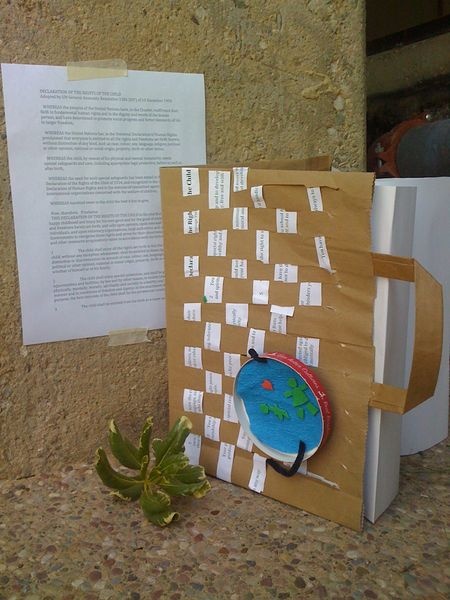Our Rights of the Child Scrapbook Remix
Goal
To have students examine the United Nation Declaration of the Rights of The Child and reflect on their own experiences through writing and visual art activities to create a scrapbook.
Objectives
The students will create a woven scrapbook exploring and weaving different genres: poetry, narrative, expository/informative and argumentative/persuasive. In preparation for the book students will need to address literacy, rights and self advocacy. This lesson will pull into current events in the local community and make connections to global scale. As an extension teachers can digitize pieces from the individual books and tie into a longer documentary piece.

Materials
One standard brown paper bag will make two book covers
Two copies of the Rights of the Child per student http://www.tolerance.org/supplement/ten-core-rights-united-nations-declaration-rights-child
Glue
Scissors
Optional Materials
Colored Paper
Recycled Magazines for images
Colored Pencils
Colored Markers
String
Ribbon
Plastic Bags woven into strips for weaving into the book jacket (Make sure to rinse and dry of any liquids so as to not attract insects.)
Preparation
1. Revisit the Post World War II Era and the development of the United Nations.
2. Revisit the different types of writing: poetry, informative, narrative and argumentative. All these genres will be incorporated in the scrapbook.
3. Revisit color theory, pointillism, line drawing, weaving and bookmaking. For this scrapbook we will use the Japanese accordion style book making technique.
Activity
Students document all activities in their scrapbook
Activity I: Post the following prompt on the board: Draw or write about a world where all children have happy childhoods. What would this world look like? Take 5 to 10 minutes to generate ideas.
After students share in pairs, come together in a large group and collect students ideas on the board.
History Lecture Background for the creating the Declaration of the Rights of a Child see references at the end of the unit. Resources: Rights of the Child & Lesson Modules
Post Big Ideas on Board: How has the Declaration of the Rights of the Child helped develop policies and organizations for children around the world? What current events are impacting the rights of children? What is the current position of United States in relation to children rights? What function do non-profit and government organizations play in the life of children? How do they advocate on behalf of children? Looking through the historical lens what factors lead to the development of the Declaration of the Rights of the Child? What other directions could the world have taken if the Declaration of the Rights of Child had not been developed, created, adopted and put into practice? What areas of world on a local or global scale benefit from revisiting this document and putting it into practice?
Hand these questions to the students and have them discuss in small groups, next have them write the ideas in their learning logs. Have students share aloud then gather ideas on large paper or board. Next have the students generate more ideas on the rights on the rights of the child? What new ideas have come across as they revisit this historical document?
Vocabulary: Have the students begin to keep a running vocabulary list of the words they come across in their learning log and the cognates of these words.
Activity II Reread the Declaration of the Right of the Child Take the First right then cut words out to create a haiku. First line should have 5 syllables. Second line should have 7 syllables. Third line should have 5 syllables. This exercise is meant to generate deductive reasoning and summary skills.
Haiku Example:
Right to what follows
Race, sex, color respect all
Right to opinion
Next have students choose one of the ten rights; they can work alone or in pairs. Have them create their own haiku.
Reread the Declaration of the Right of the Child and have the students explain in their own words what rights are protected? What benefits are promised by this document?
Activity III Argumentative Prompt: In their opinion which right do you believe needs to be protected the most? What do other authors, your friends or you think about this document? How are children's rights currently being respected or denied locally? On a global scale how are children's rights being respected or denied?
Resource: Argument Writing
Activity IV Discuss color theory, pointillism, line drawing, cut outs as an option for illustrations. Have the students illustrate one of their ideas and place in their books.
Resources: Color Theory, Pointillism, Drawing, Cut and Paste
Activity V Optional Wordle Cloud: Have students cut and paste one part of the Declaration of the Rights of the Child or type in their own writing. Have the student create a wordle cloud. Print and cut and paste into their scrapbook.
Activity VI Write an autobiography and include it into your scrapbook.
Resource: Portraits Visual & Written
Activity VII Design your own self-portrait.
Resources: Looking at One's Self